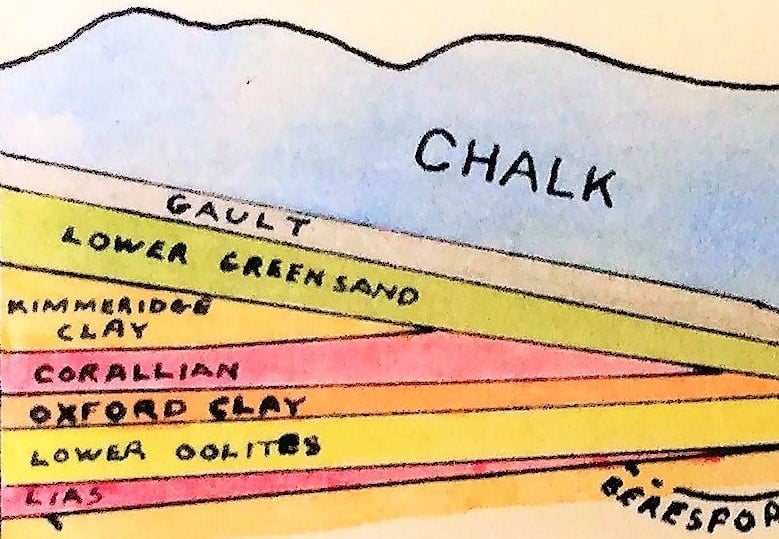Rocks and Fossils activity 1: Strata for Starters – the rock layers of Folkestone
Overview
KS2 children explore the work of William ‘Strata’ Smith and create a giant cross-section of the rock layers at Folkestone - including real fossils.
Learning objectives
Increased knowledge and understanding of rocks, fossils and geology, especially that sedimentary rocks are laid down in layers over millions of years with the oldest at the bottom and more recent ones on top.
Curriculum links
KS1-2 Science (rocks and fossils, erosion, rock layers (stratigraphy).
KS1-2 Art (creating a collaborative piece of art in a range of media)
Encourage children to explore the Rocks and Fossils topic on the Learning from Objects website to discover different rocks and fossils from Folkestone and East Kent and how they formed.
Children are set the task to Research William ‘Strata’ Smith, who created the first geological map of Britain in 1815. There is some excellent material about him at this URL:
https://www.geolsoc.org.uk/Library-and-Information-Services/Exhibitions/William-Strata-Smith
Children are also set the task of researching the rock layers (strata) of the Folkestone area.
What are the different rocks at Folkestone and how old are they?
There is lots of information about Folkestone and Kent geology online. These websites are particularly useful for teachers and older pupils.
GeoConservation Kent
https://www.geoconservationkent.org.uk/
British Geological Survey
http://mapapps.bgs.ac.uk/geologyofbritain/home.html
This part of the British Geological Survey site allows you to zoom in on Folkestone geology and even look at borehole data for the depth of different rock layers below the surface at that specific location.
https://www.bgs.ac.uk/discoveringGeology/geologyOfBritain/viewer.html
This image shows the rock layers near Folkestone with chalk at the top down to the carboniferous (coal measures) rock layers the including the Beresford coal seam.
The class then make their own cross-section of the strata at Folkestone (showing the different layers of rock laid down over millions of years) with the oldest rocks at the bottom and the most recent at the top.
For maximum impact suggest they work collaboratively at an impressively large scale, making their finished cross section(s) the height of the classroom.
This will have the current street level at the top (with buildings people and sky) with top soil immediately below that, then chalk, gault clay, and lower greensand with even earlier layers beneath (all underground at Folkestone), but including the rocks and plant fossils of the coal measures (carboniferous) where Kent coal was found and mined deep underground (up to 915 metres down at Snowdown Colliery, Aylesham). Suggest this is the lowest layer on your cross-section (though obviously the rocks continue down much further until they eventually turn to molten magma!
Explore the Rocks and Fossils topic for examples of fossils to include, as carefully sketched drawings, in the relevant layers (chalk sea urchin fossils in the chalk layer for example).
You might even include (on a small table next to it) labelled samples of some of the different types of rocks and fossils, either collected on a school field trip to East Wear Bay, brought in by children who have been there with their families, or from the Folkestone Museum Rocks and Fossils Loan box.
Folkestone’s visible geology comprises three distinct layers of sedimentary rock.
NB Later layers of rock have been eroded leaving the Chalk layer at the surface.
Chalk (upper layer) began to form about 100 million years ago from the compacted remains of microscopic algae called coccoliths. Fossilised ammonites, bivalves and sea urchins are common but fish and marine reptiles, including ichthyosaurs, can also be found.
Gault Clay (middle layer) As the sea level rose about 112 million years ago, particles of silt formed a layer called Gault Clay. Ammonites, crustaceans, fish and reptiles, along with microscopic animals called foraminifera inhabited the sea. Gault fossils are easily found on the beach at East Wear Bay.
Lower Greensand (lower layer), formed under shallow seas about 120 million years ago, was originally a sandy seabed and animal burrows can be seen fossilised in the rock. Ammonites, oysters, sea urchins and reptile fossils can also be found.
Learn with Objects links
Use Learn with Objects, Rocks and Fossils 1-11 for info and images.


